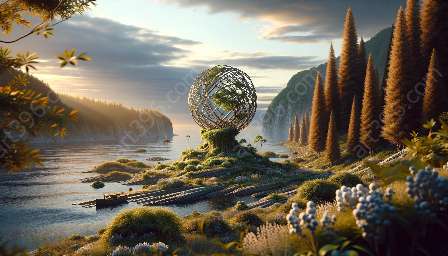Environmental art installations possess the power to inspire, provoke, and challenge our perceptions of nature and sustainability. The use of renewable energy sources in these installations can further amplify their impact, promoting not only artistic expression but also environmentally sustainable practices. This piece focuses on the integration of renewable energy sources into material-driven environmental art installations, exploring innovative approaches that marry art, sustainability, and innovation.
Art as a Tool for Environmental Awareness
Environmental art, also known as eco-art or land art, often utilizes natural materials to create site-specific works that reflect and respond to the surrounding environment. Art installations in public spaces, galleries, and outdoor settings serve as a platform for raising awareness about environmental issues and encouraging dialogue about our relationship with the natural world.
Material Use in Environmental Art
The material-driven approach in environmental art emphasizes using sustainable, ethically sourced, and eco-friendly materials that align with the theme of the art installation. Artists may choose to work with natural elements such as wood, stone, or earth to create visually compelling and conceptually meaningful pieces that resonate with the audience while minimizing the environmental impact.
Integrating Renewable Energy Sources
Incorporating renewable energy sources, such as solar panels, wind turbines, or kinetic energy harvesters, into material-driven environmental art installations presents a unique opportunity to blend art with sustainable technology. By harnessing the power of nature, artists can infuse their creations with a dynamic, interactive element that not only complements the artwork aesthetically but also contributes to reducing the carbon footprint of the installation.
Solar-Powered Art Installations
Solar panels integrated into the design of art installations can capture sunlight and convert it into electrical energy, providing a renewable source of power to illuminate the artwork or operate interactive features. The juxtaposition of organic materials and solar technology can create an intriguing contrast, symbolizing the harmony between nature and innovation.
Wind-Powered Art Installations
Wind turbines can be incorporated into environmental art installations to harness the kinetic energy of the wind and transform it into electricity. The graceful movement of the turbines and the visual impact they create can merge seamlessly with the artistic elements, complementing the overall visual and environmental narrative of the installation.
Kinetic Energy Harvesting
Using kinetic energy harvesting mechanisms, such as piezoelectric materials or motion-powered generators, offers artists the opportunity to engage the audience in an interactive and participatory experience. Visitors' movements within the installation space can generate energy that activates light, sound, or kinetic elements, blurring the boundaries between the observer and the artwork.
Sustainability and Innovation in Art
By integrating renewable energy sources into material-driven environmental art installations, artists not only contribute to the sustainable energy movement but also serve as pioneers in integrating innovation, technology, and artistic expression. These installations become dynamic creative laboratories, where the boundaries between art, technology, and sustainability are reimagined and expanded.
Conclusion
The marriage of renewable energy with material-driven environmental art installations holds the potential to captivate, educate, and inspire audiences while promoting sustainable practices and environmental consciousness. As artists continue to explore the intersection of art, sustainability, and technology, the possibilities for creating impactful and thought-provoking installations that embody both creativity and ecological responsibility are limitless.

